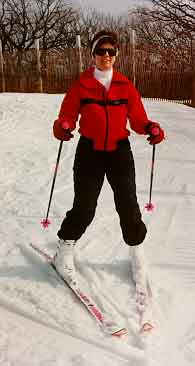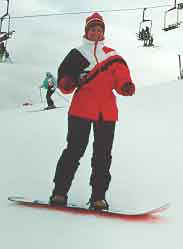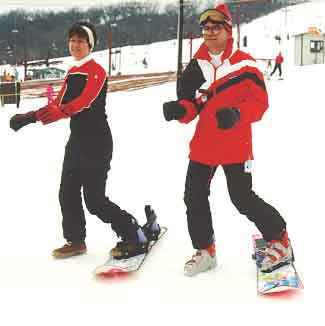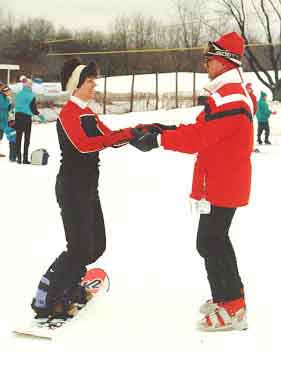EXPERIENCED ALPINE INSTRUCTION
THE EXPERIENCED ALPINE SKI INSTRUCTOR AS
BEGINNING SNOWBOARD INSTRUCTOR
by
Chuck Roberts
The ever increasing popularity of snowboarding has not gone unnoticed
by ski schools and ski instructors. Snowboarding lessons are an established
offering at most ski schools across the country. Experienced snowboarders
who have never taught alpine skiing are
joining ski schools to teach snowboarding.
Experienced alpine ski instructors have taken up snowboarding
and are becoming "bilingual", teaching both snowboarding and alpine skiing.
The reasons include the need for snowboard instructors,
the challenge of snowboarding, the chance to develop
snowboarding skills, a broadening of the comfort zone and the opportunity
to contribute teaching experience to the rapidly evolving snowboard teaching
methodology.
The purpose of this article is to provide a guide for the experienced alpine
ski instructor when crossing over to beginning snowboard instruction. Can
the experience
of alpine instruction be applied to snowboarding? What experience can be
transferred and what experienced must be attained?
The experienced alpine ski instructor who is anticipating the experience of
the first snowboard lesson has undoubtedly scanned PSIA literature regarding
snowboard instruction.
Questions as to the ease or difficulty in handling beginning snowboard
lessons are probably on the mind of many potential snowboard instructors.
Some snowboard enthusiasts claim that it is as easy to learn as alpine
skiing.(Ref.1) Others
suggest a more difficult
learning curve than snow skiing (Ref.2).
Lets see if we can sort out the similarities and differences
LESSON TIME REQUIRED TO LEARN HOW TO TURN
Does the beginning snowboard lesson require the same amount of time to learn
how to turn as that required for an alpine lesson?
According to the most recent PSIA manuals the recommended progression in
teaching the beginning lesson is slightly longer for snowboarding
when compared with down hill skiing. (Table 1)
TABLE 1 RECOMMENDED PROGRESSION
ALPINE SKIING SNOWBOARDING
_______________ ______________
level terrain maneuvers level terrain maneuvers
straight glide straight glide
gliding wedge heel and toe sideslip down fall line
wedge turn falling leaf
skidded traverse
garlands
basic skidded turn
Likewise there are more goals to be achieved in the level 1 snowboard
lesson when compared to the Level 1 alpine skiing lesson as indicated
in Table 2.
TABLE 2 LESSON GOALS
Beginning Alpine Lesson Goals (Ref. 3)
*Familiarity with equipment, new movements, and a new
environment.
*Learning the basics of walking, straight running, and
braking/gliding wedge
*Developing the sensations of moving and sliding
*Ability to vary speed and stop by controlling the size of the
wedge
*Introduction to wedge turns
*Developing group interactions, dynamics and experiencing the
mountain environment
Beginning snowboard Lesson Goals (Ref. 4)
*Introduce the student to the mountain environment
*Discuss mountain safety issues
*Orient students to equipment
*Introduce the student to a balanced, efficient and upright
stance
*Introduce basic maneuvers with only the front foot in the
binding: walking, stationary turning, climbing, skating
**Straight gliding in a balanced, upright, efficient stance
**Sideslipping, controlling slipping speed by edging, both
toe and heel edge
**Falling leaf: controlling the direction of sideslipping
relative to the fall line
**Traversing, both toe and heel side, without necessarily
holding the edge (forward and backward (fakie) skidding
traverses)
*Do a standing, skidded stop on both edges
It should be noted that, in the Level 1 snowboard lesson, basic turns
are not one of the goals. First turns are introduced in Level 2.
Snowboard progression recommends maneuvers such as sideslip,
falling leaf and traverse which are often used at the higher alpine skiing
levels. Snowboarding is an asymmetrical sport. The heel turn
is different from the toe turn, requiring more time to teach and
learn what may be considered two maneuvers.
In alpine skiing the left and right turns are similar, with the direction
of the steering, pressure control, etc., being the only difference.
Consequently when crossing over to snowboard teaching, the
expectation that a beginning snowboard lesson would
result in beginning turns
with the same amount of students in the same amount time as the beginning
alpine skiing lesson is optimistic.
Alpine beginning ski lessons in the Midwest typically range from 1 hour to one and one half
hours for day resorts as opposed to destination resorts, where a beginning
lesson may be several hours. During that hour, there is a good chance that
all alpine students (about 10-12 students)
will at least learn how to turn and ride a lift.
In the beginning snowboard lesson, 2-5 students would probably take
over 2 hours to learn to turn. (Ref. 1)
In a nutshell, the experienced alpine ski instructor should anticipate longer
teaching time to achieve the basic snowboard turn because of the additional
goals and skills required.
TEACHING METHODOLOGY
Can the technique and experience gained teaching alpine beginners
be transferred to teaching snowboard beginners?
Part 1 of the snowboard manual presents
the American Teaching System, and Part 2 reviews basic concepts in teaching
and learning which are virtually identical to the alpine skiing manual.
At recent Central Division snowboard clinics, the teaching performance
of experienced alpine instructors turned snowboard instructors was
clearly an asset
when compared to snowboard instructors without
any teaching experience.
Finally, the learning partnership of the teaching model is the same for
both alpine skiing and snowboarding,
concluding that teaching methodology is easily transferred.
BEGINNING SKILL DEVELOPMENT
(Balance and the Basic Stance)
Can the experience of the development of beginning alpine skill levels be
transferred to the beginning snowboarder?
Level terrain maneuvers such as walking, turning, learning how to
get up, skating
and the basic skiing stance are a part of the beginning alpine skiing lesson.
Mastering most of these maneuvers will help in performing the wedge.
However few instructors would hold
up a student if their positioning, for instance, was marginal.
When teaching skiing, the gliding wedge/wedge turn model acts as a stable
platform to develop skiing skills.
Shown below is a view of the basic beginning wedge position,
a very stable configuration.

One can sit back, under edge, over edge, bend at the
waist and still perform a rudimentary wedge turn.
The secret, of course, is the relatively wide base formed by the
wedge stance.
This has proven to be a successful concept since
students can have fun early on in the skiing experience by actually being
able to ski.
When teaching snowboarding, the correct basic stance is necessary early on.
Shown below is a snowboard stance which requires slightly
more skill to achieve
when compared to the wedge position.

Deviations of the center of mass from the correct position on the board
can result in a variety of motions that may not be anticipated by the
beginning snowboarder.
For instance,
having the center of mass back on the
board can result in the rider (snowboarder)
going downhill backward, an accepted
way to ride (fakie) which is developed in more advanced lessons but
certainly not recommended for beginning lessons.
More effort is required on the part of the instructor to instill the basic
stance in the student.
With both feet attached to a single board, the width of the stance is fixed
and not variable like the wedge position.
It is a common instruction techniques to spend time
with the student's rear foot out of the binding
to aid in balance development.
Shown below is a typical static exercises performed by snowboard
instructors to aid in proper positioning and balance development.

Consequently, the student's
attainment of the required balance will be more of a challenge
in the beginning snowboard lesson.
Actual physical contact with the alpine
skier student to aid in the balanced stance
is usually not needed, although it may be helpful with an unusually
timid or poorly coordinated student.
Physical contact with the beginning rider to
aid in attaining initial balance has been found to be very helpful.
 As shown above the instructor aiding a student in a balanced stance while
performing an elementary heel side
sideslip. The instructor has momentarily removed
his snowboard to facilitate guiding the student in the sideslip.
This technique helps the student perform the sideslip with the instructor
in a good position to help correct balance
difficulties. The student can explore a wide range of anatomical inputs
into the snowboard with the confidence of having an instructor literally close
at hand.
As shown above the instructor aiding a student in a balanced stance while
performing an elementary heel side
sideslip. The instructor has momentarily removed
his snowboard to facilitate guiding the student in the sideslip.
This technique helps the student perform the sideslip with the instructor
in a good position to help correct balance
difficulties. The student can explore a wide range of anatomical inputs
into the snowboard with the confidence of having an instructor literally close
at hand.
BEGINNING SKILL DEVELOPMENT
(Pressuring)
Will beginning snowboard students benefit from prior alpine experience?
The physical conditioning and balance developed in other sports is always
an asset. Certain skills such as pressure control may not be directly
transferable. The alpine student learns to apply pressure to the tip of
the ski using forward pressure on the foot, forward lean, etc. Edge pressure
is accomplished through lateral body movements, angulation,
etc. In snowboarding the student's feet are not pointing
in the direction of travel but are typically at a 90 degree to a 45 degree angle.
The snowboarder applies lateral pressure to the foot in order
to apply more pressure to the front of the snowboard, and toe or heel
pressure
to achieve edge control. The sensation is somewhat opposite of
alpine skiing.
Consequently, because of these basic differences in the two sports, the
instructor should expect to attain new experience in developing snowboard
pressure control skills.
BEGINNING SKILL DEVELOPMENT
(Edging vs Rotary)
When teaching beginning skiing, edging skills are nearly optional.
Wedge turns can be accomplished by beginners without much thought
about edging,
since
the anatomy of the typical skier and the slope usually provide
sufficient edging in
the wedge position.
Rotary skills, which are easier to perform than edging skills, are encouraged.
As they graduate to higher levels of skiing, edging is
developed with the sideslip, traverse and uphill christie.
When teaching snowboarding, edge awareness is very important.
Sideslipping is often introduced in the beginning lesson before the ri



